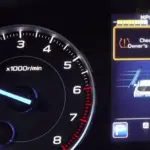How to Turn Off Brake Light on Dashboard?
Picture this: you’re cruising down the highway, your favorite tune is playing, and you’re just about hitting that sweet spot of a drive. Then, out of nowhere, the brake light on your dashboard decides it’s time to crash the party. Annoying, right? Well, fear not, fellow driver! Today, we’re diving into the world of automotive troubleshooting – specifically, how to turn off that persistent brake light on your dashboard.
January 31, 2024
Table of ContentsShow
Understanding the Culprit Behind the Light
First things first, let’s understand our adversary. The brake light on your dashboard isn’t just a bulb with a bad attitude. It’s actually a warning signal. Think of it as your car’s way of saying, “Hey buddy, something’s not right with my brakes!” So, before you go all Mission Impossible on your dashboard, let’s decode what could be triggering this light.
Possible Reasons for the Illuminated Brake Light
Low Brake Fluid:
This is like your car’s way of being thirsty. Low brake fluid levels can trigger the light.
Worn Brake Pads:
Imagine running a marathon in old, worn-out shoes. Not fun, right? Your car feels the same about its brake pads.
A Faulty Sensor or Connection:
Sometimes, it’s just a case of your car’s computer having a bit of a moment.
Step-by-Step Guide to Turn Off the Light
Check the Brake Fluid Level
Locate the Brake Fluid Reservoir:
This is usually near the firewall on the driver’s side. If you’re lost, the owner’s manual is your treasure map.
Check Fluid Level:
If it’s low, topping it off might be your golden ticket to turning off that light.
Inspect the Brake Pads
Visual Inspection:
Peek through the wheel spokes. If the pad thickness is less than ¼ inch, it’s time for a change.
Listen for Sounds:
If your car is singing the song of screeching brakes, that’s a not-so-subtle hint.
Look for a Faulty Sensor or Connection
Sensor Check:
This can be tricky, but a visual inspection of the sensor and its connections can sometimes reveal the issue.
Professional Help:
When in doubt, it’s always wise to consult a professional. After all, we can’t all be car whisperers.
When DIY Just Doesn’t Cut It
There comes a time when even the most enthusiastic DIYer has to throw in the towel and seek professional help. If you’ve tried all the above steps and that light is still shining brighter than your future, it’s time to visit a mechanic.
Preventive Measures – Because Prevention is Better than Cure
Regular Maintenance:
Treat your car to regular check-ups. It’s less about pampering and more about prevention.
Mindful Driving:
Avoid sudden braking and treat your car’s brakes with a little tenderness.
The Light at the End of the Tunnel
So there you have it, folks! Dealing with a brake light on your dashboard can be a bit of a headache, but with a little patience and some elbow grease, it’s usually something you can handle on your own. Remember, when in doubt, don’t hesitate to seek professional help. Your safety is always the top priority.
And lastly, keep in mind that while we love a good DIY challenge, there’s no shame in admitting defeat and letting the pros handle it. After all, we can’t all be car gurus. Happy driving and may your dashboard lights always be the boring kind!


